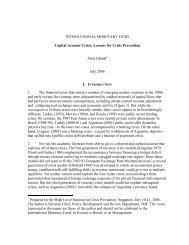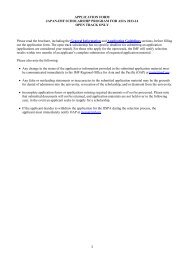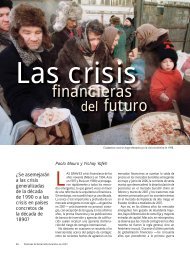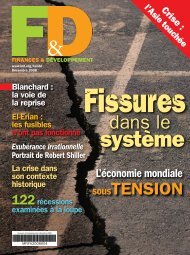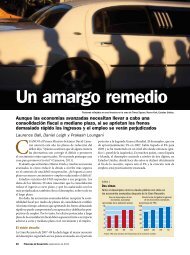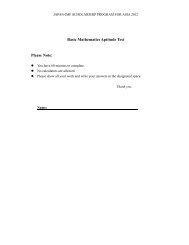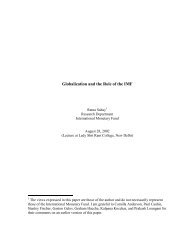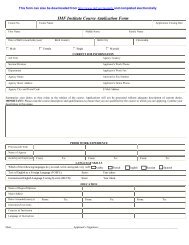Chapter 20: Taxation of Corporate Reorganizations - IMF
Chapter 20: Taxation of Corporate Reorganizations - IMF
Chapter 20: Taxation of Corporate Reorganizations - IMF
Create successful ePaper yourself
Turn your PDF publications into a flip-book with our unique Google optimized e-Paper software.
Tax Law Design and Drafting (volume 2; International Monetary Fund: 1998; Victor Thuronyi, ed.)<br />
<strong>Chapter</strong> <strong>20</strong>, <strong>Taxation</strong> <strong>of</strong> <strong>Corporate</strong> <strong>Reorganizations</strong><br />
3. Tax Position <strong>of</strong> the Transferee Company<br />
The transferee company is not taxed in a merger unless it is at the same time a<br />
shareholder <strong>of</strong> the transferor company. This special case will not be discussed here. In a<br />
reorganization, the transferee company is mainly interested in what happens after the<br />
reorganization. The position <strong>of</strong> the transferee company is determined by two elements: (a) the<br />
tax basis <strong>of</strong> the assets received from the transferor, and (b) the carryover <strong>of</strong> other tax attributes <strong>of</strong><br />
the transferor.<br />
A. TAX BASIS OF THE ASSETS TRANSFERRED<br />
The rules for determining the tax basis to the transferee company after the merger are<br />
roughly the same as the rules for determining the tax basis <strong>of</strong> the new shares on behalf <strong>of</strong> the<br />
shareholders <strong>of</strong> the transferor company. To the extent that the transfer <strong>of</strong> assets is taxed to the<br />
transferor company there will be a revaluation <strong>of</strong> these assets for tax purposes; to the extent that<br />
the transfer <strong>of</strong> assets has been tax free, the transferee company will carry over the tax basis that<br />
those assets had before the reorganization in the transferor company. 80<br />
The problems <strong>of</strong> allocating the amount <strong>of</strong> taxable pr<strong>of</strong>it to various categories <strong>of</strong> assets<br />
(inventory, fixed assets, goodwill) have been discussed in connection with taxable transactions. 81<br />
These problems are exactly the same in a partially tax free merger. To the extent <strong>of</strong> the amount<br />
taxed, the increase in tax basis has to be allocated over several categories <strong>of</strong> assets. The<br />
valuation <strong>of</strong> the assets in the reorganization will be decisive in allocating the amount <strong>of</strong> pr<strong>of</strong>it<br />
realized by the transferor. When the reorganization is completely tax free, there is no problem <strong>of</strong><br />
allocation, because the existing tax basis <strong>of</strong> the assets <strong>of</strong> the transferor company is carried over.<br />
B. DISPARITY BETWEEN TAX ACCOUNTING AND COMMERCIAL ACCOUNTING<br />
The carryover <strong>of</strong> the old tax basis <strong>of</strong> the assets <strong>of</strong> the transferor company in a tax-free<br />
reorganization may result in a disparity between tax accounting and commercial accounting,<br />
depending on the accounting rules in the tax jurisdiction. Basically, a reorganization can be<br />
accounted for by either pooling accounting or purchase accounting.<br />
Pooling accounting consists in carrying forward without any change all book items <strong>of</strong> the<br />
transferor company as they existed before the reorganization. It is the accounting method that is<br />
recommended for tax-free reorganizations in the United States, because the accounting rules<br />
coincide with the tax rules.<br />
80 E.g., BEL CIR § 212; USA IRC § 362(b). In France, a distinction is made between depreciable and nondepreciable<br />
assets. For nondepreciable assets such as land and securities, there is a single carryover <strong>of</strong> the old tax basis; see FRA<br />
CGI § 40, 151 octies. For depreciable assets, the capital gain that has been exempted must be reintegrated in taxable<br />
pr<strong>of</strong>its over a period <strong>of</strong> 15 years after the merger; see CGI § 210A(3)(d). The argument has been made that in the<br />
context <strong>of</strong> privatized enterprises in transition economies, it may not make much sense to provide for basis carryover,<br />
because the basis may bear no relation to reality. The alternative would be to allow such enterprises a fresh start<br />
valuation at market value without requiring recognition <strong>of</strong> gain. See Kodrzicki and Zolt, supra note 5, at 629–33.<br />
81 See supra sec. III.<br />
- 24 -





